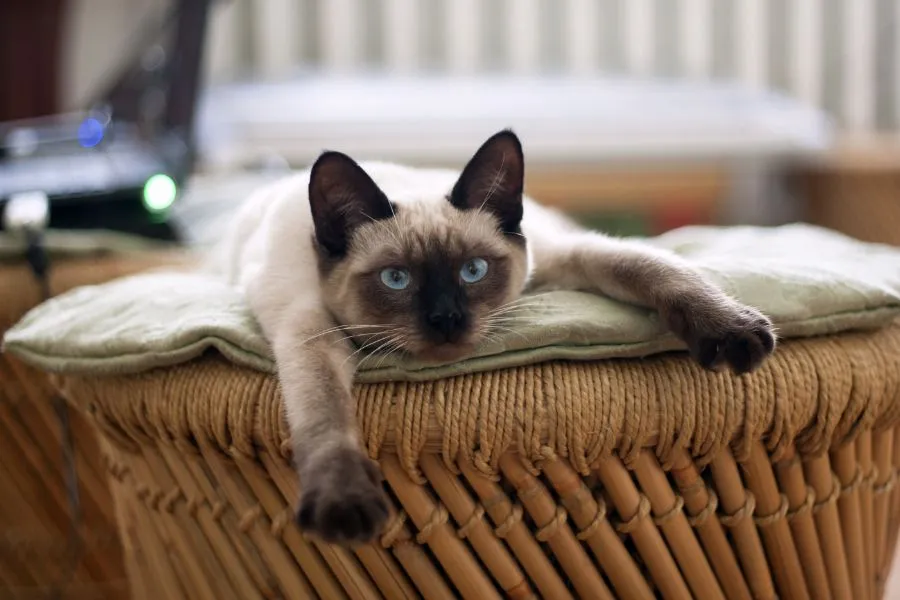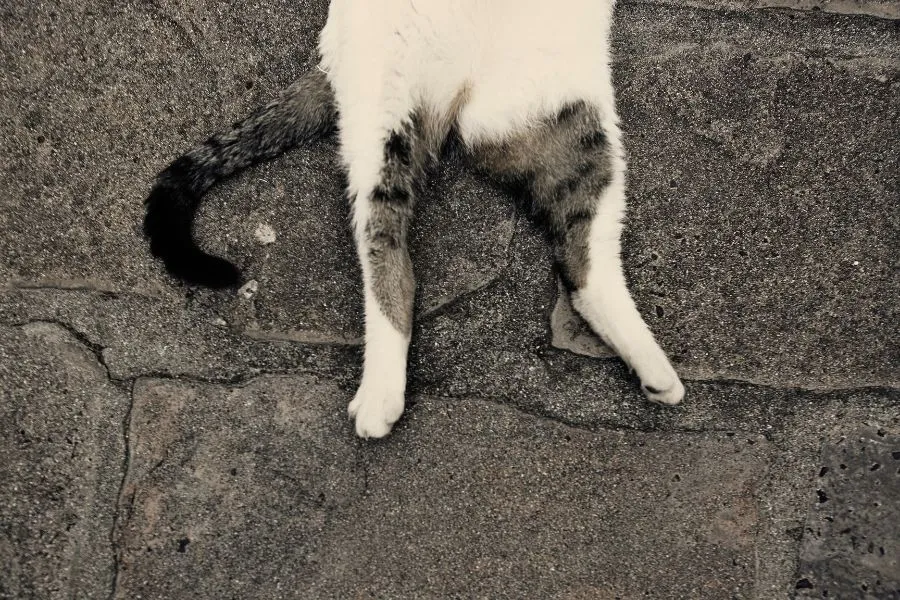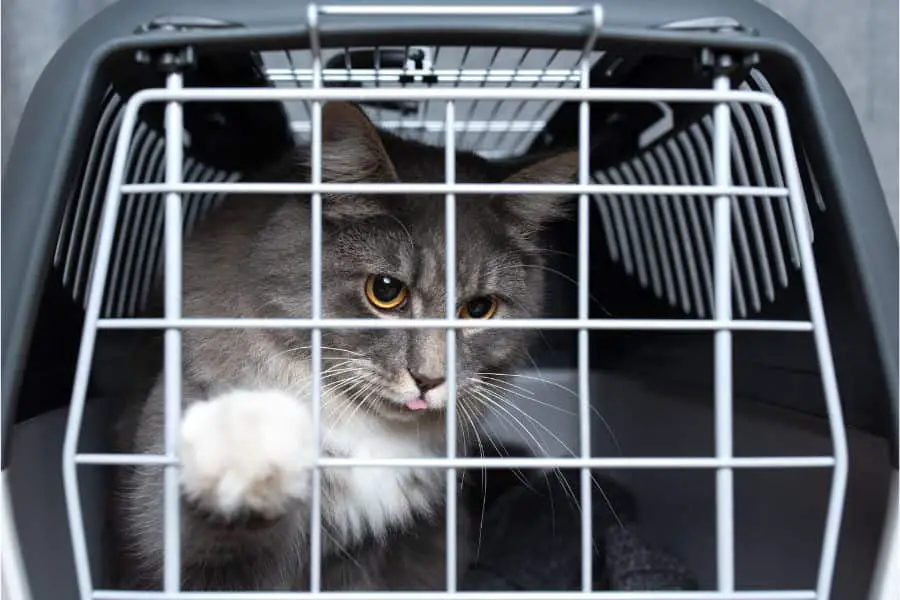You know how problematic it can be if you’ve seen your beloved cat limping.
You’ve probably asked yourself a million questions:
- Is my cat in pain?
- What could have caused this?
- Is it something serious?
In this blog post, we’ll explore the various causes of cats limping and answer the big question – should you be worried?
Let’s start digging in to find out what is causing your cat to limp!
Cat Limping
If you notice your cat limping on one or both back legs, it is essential to assess the situation and seek veterinary care. You should not be overly concerned if your cat suddenly begins limping, as this issue can often be treated with rest and recovery.
However, if your cat is having trouble walking, appears in pain, or is limping for a prolonged time, it could indicate a more severe condition.
Here are some common causes for when your cat is limping back leg.
Injury
Injury may cause lameness in more active cats or suffer from trauma, such as falling from high places.
Accidents can also occur due to rough play or contact with other animals, mainly if claws are involved.
In cats that go outdoors, there is also the risk of being hit by cars or other moving objects that can cause severe injury resulting in lameness.
Arthritis
Cats will often limp due to arthritis pain caused by inflammation in their joints and bones if they are allowed to become overweight.
This increases strain on their joints which may lead to painful lameness with age. If left unresolved, the issue may worsen significantly, leading to decreased mobility or the inability to walk at times altogether.
Infection
Cuts, punctures, bites, and abscesses can quickly go unseen as infections within cats that may affect any area of their bodies, including legs and paws.
Eventually result in swollen limbs and painful acute inflammation, causing them significant discomfort while walking, which leads them to limp on one or both back legs depending on where the infection lies.
Animal owners should always watch for any changes in behavior, whether it be eating habits or signs of physical distress. They may be able to identify early signs of illness before symptoms become more severe and require more extensive medical attention.
As soon as you notice your feline friend is showing signs of limping, it would be best to examine her so a diagnosis can be made.
Proper treatment plans are determined as soon as possible for optimal recovery success rates!

Causes of Cat Limping
If your cat is limping on its back leg, you might be worried about the underlying cause. There are various reasons a cat may experience difficulty walking on its back leg, and it is essential to distinguish between them.
Generally, the most common causes of cat limping are broken bones, arthritis, muscle strain or sprain, and ligament problems.
A broken bone is one of the cats’ most severe causes of limping. Fractures can occur due to sudden accidents or pre-existing conditions such as weak or brittle bones.
In these cases, the affected leg should not be moved and should be stabilized until veterinary assistance is acquired.
Clinical examination and imaging techniques such as X-rays will help determine if there are any fractures present in a cat’s legs.
Arthritis is another common cause of stiffness in cats that can lead to limping and decreased mobility.
Arthritis pain can affect both joints in a limb or just one joint, leading to an inability to walk normally on that limb.
Additionally, inflammation due to arthritis will often result in painful swelling around the joint, making it difficult for a cat to move their limbs properly without limping when walking.
Muscle strains and sprains are another possible cause of limping in cats. These injuries usually occur when the muscles have experienced rapid changes in activity level, resulting in damage or trauma occurring within them.
With muscle strains and sprains, swelling often appears, restricting how much movement a particular limb can do—resulting in the cat being unable to walk normally on it until it has had time to heal itself.
Finally, ligament problems such as those associated with an anterior cruciate ligament tear are another factor that could cause a limp in cats.
An ACL tear often appears suddenly due to sudden trauma, letting very little time for ankle injury-related pain relief methods before clinical inspection must be completed.
Seeking veterinary assistance if your cat begins limping throughout its daily routine helps ensure any painful injuries like those listed above are diagnosed correctly.
You can provide appropriate care needs quickly and efficiently, helping them cope with the effects caused by these circumstances more easily over time.
How Serious is a Limp?
It is known as limping when your cat has difficulty walking with one of its back legs. Depending on the cause of the limp, it can range from minor to severe. You should be aware of the possible causes so you can work to determine the best course of treatment and provide relief for your furry friend.
The most common causes of limping in cats include trauma, arthritis, abscesses, infections, growths or tumors near the joints, and muscular issues.
If an injury has caused trauma, such as a broken bone due to an accident or animal attack, there will be obvious signs, such as swelling, pain, and lameness.
Once an orthopedic surgeon has determined that a fracture is a present treatment for limping depends mainly on the extent of the damage and the specific type of fracture.
If arthritis or other degenerative joint conditions are causing your pet’s limping, a veterinarian may prescribe medications to manage or reduce discomfort.
A vet will determine if supplements such as arthritis aid would benefit your cat and make changes to their diet, which might help reduce inflammation.
Additionally, they may suggest exercise therapy if appropriate. Limps caused by joint infections are less common but require antibiotics and potentially additional treatment, such as surgery if necessary.
Limps caused by growth are also less common but still occur. Treatment depends greatly upon whether the change is cancerous and how far it has progressed before being discovered, so early detection is critical for these issues.
Limps associated with muscular problems usually manifest more localized pain when touched rather than completely blown lameness.
Limps can still be treated in many situations through physical therapy or medications prescribed by a veterinarian, depending on the severity of the case; surgical measures may also be taken depending on the nature issue in question.
It’s essential, however, first to find out the underlying cause of why your cat limps on their back leg. Otherwise, the problem could worsen as time passes without a resolution!

What Should I Do if My Cat is Limping Suddenly?
If you have noticed that your cat is limp, it can be alarming and worrying. Cats are agile creatures, and limping is a tell-tale sign that something might be wrong with your pet.
When your cat is discovered limping suddenly, the first step should be a trip to the vet to check it out.
Before the visit, you should take a minute to observe the limp.
- Is there redness or swelling?
- Is the area warm?
- Does the cat flinch or wince when palpated in that spot?
Such observations can help veterinarians diagnose and treat your pet as quickly and appropriately as possible.
There are many possible causes of cats limping, ranging from trauma – such as being hit by a car – or apparent slips and falls through infections or chronic conditions such as hip dysplasia arising from old age or genetics factors, heel injury from overstretched tendons, and diseases such as feline infectious anemia (FIA). Such underlying causes for lameness can vary within age groups, sexes of cats, and breeds.
Suppose your cat has had an acute onset of limping after experiencing trauma. In that case, immobility with rest may be best for recovery, along with appropriate first aid treatment at home.
At the same time, professional advice should still be urgently sought when specific symptoms persist after several days, even after resting.
On the other hand, if a persistent limp has been present before any activity is taken, it may be time to speak with vets about potential treatments, including antibiotics for infections and physiotherapy exercises intended to help reduce pain while promoting healthy movement.
Surgery may also be applied depending on the cause of the limp to remedy excessive strain off certain joints or ligaments, debilitating function in extreme cases if necessary.
When Should I Take My Cat to The Vet For Limping?
If you notice your cat limping, especially on its back leg, it’s essential to take them to the vet as soon as possible. While crawling is often a sign of a minor issue such as sprains or strains, it could also indicate a more severe problem such as an injury, illness, or cancer.
When deciding when to take your cat to the vet for limping back leg issues, it’s best to consider several factors, such as the severity of the limp and duration.
If your pet is clearly in pain, appears uncomfortable, or has been limping consistently for longer than 24 hours, then it’s time to visit the vet.
Your veterinarian will be best suited to determine why your furry companion is limping by conducting an examination and gathering any necessary diagnostic tests.
This could include imaging (e.g., x-rays), blood tests, and more, depending on what they suspect may be causing the issue.
In conclusion, when your cat begins limping – especially on their back leg – you should take them to the vet immediately if they are in pain or if they play lameness that persists for greater than 24 hours duration.
Can a limping cat heal itself?
If your cat is limping or hobbling around, it could be due to various reasons. Most cats can heal naturally, and limping usually goes away independently.
However, if the limp persists, you should take your pet to the veterinarian as soon as possible.
Depending on the cause of the limping, a cat may need other types of treatment than just rest and time.
Injuries such as broken bones or strained muscles may require specific treatments and medications that a qualified veterinarian can only administer.
It’s also important to recognize that some underlying conditions may be causing your cat to limp.
These conditions might include joint diseases, nerve damage, or infections which must also be treated medically for the limping to cease.
If your cat does seem fine after its injury has healed, it’s essential to keep an eye on any changes in its gait from time to time. Suppose the problem recurs or worsens over time.
It would be best to take them back for further investigation with a vet as soon as possible because an underlying condition may be present and should not be ignored.
Limping can often lead to chronic health problems such as arthritis in cats due to joint wear and tear, so you should speak with your vet about what’s happening when you notice any subtle changes in their gait.
Suppose your cat seems fine after a few days without any treatment at home. In that case, you can give them supportive care, like providing food and water in easily accessible areas and enough space within your house to move freely, which will help speed up their recovery.
Further pursuing treatment could cost you more than necessary if there isn’t anything significant wrong with them at that point.
They are being observant of any signs or symptoms of a worsening condition. Providing them with enough love & care while they are healing should ultimately lead to eventual resolution.
However, if no improvement is seen after 7-10 days from when their limp appeared, then seeking medical attention would be necessary at this stage for them to start to heal perfectly again!
How Should You Transport a Limping Cat?
If you have a cat limping on its back leg, transporting it cannot be easy, but getting your cat evaluated as soon as possible is necessary. Taking the proper precautions will keep your cat safe and help prevent further injury.
First, decide on the best transportation method. If your pet isn’t injured badly enough to warrant an emergency vet trip, you can use a large pet carrier or box so that they are restrained during transport.
Make sure there is enough padding inside for comfort and stability. Have several pieces of thick blankets or towels handy for lining the box if needed.
Be prepared with some padding in case more protection is required from bumps or jolts during transport. Avoid picking up your cat since this may further aggravate their leg injury and increase pain or discomfort.
When you arrive at the veterinarian’s office, keep your cat safe from other animals so it can feel secure and comfortable while waiting to be seen by a doctor. Gently unload them using provided sides of the carrying container if necessary.
Use blankets or towels as sparsely as possible during transportation so that cats are less likely to cling to injuries by digging into them with their paws or claws. Be mindful not to place any items over their head that might give off anxiety-inducing loud noises, like plastic bags.
This could lead to panic in cats resulting in sporadic movements, which may disrupt the balance, further harming the affected leg area even more potent than before, bringing them into the clinic after being initially transported from home.
Finally, refrain from handling any medications a veterinary physician gives before obtaining advice from a professional about how much should be administered and when it should happen.
Improper healthcare measures may have detrimental effects on the overall health of cats!

Spend Time With Your Cat While Healing
When your cat is limping, it might be cause for concern. Limping can be caused by anything from musculoskeletal issues to infections. As a pet parent.
It’s essential to have your kitty checked out by a veterinarian if you notice any abnormal movement or behavior. Your vet will discuss a possible diagnosis and recommend the following treatment steps.
Once the underlying cause for your cat limping has been determined, there are a few things that you can do to ensure their recovery goes smoothly and quickly.
One of these is spending time with them while they heal. While cats may be independent creatures, they still crave contact and attention from their owners. It’s thought that this connection helps cats feel safe, secure, and relaxed, which can help in the healing process.
Having a routine when spending time with your cat can go a long way toward making them feel better—not only allowing them to heal from whatever caused their limp but also generally helping them relax and feel more at ease.
Incorporating things like brushing or petting, playtime with toys, and calm affection into your sessions will all help build trust in the relationship and make sure both of you come out of it better!
When caring for an injured kitty at home, remember to feed them nutritious meals and provide fresh water whenever they need it while getting regular check-ups with the vet.
If able (and potentially over small distances), take walks or let them explore outside under strict supervision. This helps us keep a closer eye on how our cats are doing health-wise and allows them to get out of the house and experience new smells & sights while earning some extra exercise!
Make sure that when spending time with cats recovering from an injury, you do not overstimulate them physically. This can delay healing time; instead, try interacting on their terms & paying attention to what works best for each cat trying to recover from limping back leg pain—they’ll thank you later!
Conclusion
In conclusion, cats that are limping with a back leg may be experiencing a variety of issues. Cat limp could be caused by simple problems such as paw infections, bruises, and sprains or more severe conditions such as arthritis, joint injuries, broken bones, or nerve damage.
If the limping continues for more than two days or further concerns, arise beyond the limb area, symptoms of pain, fever, and excessive panting should be addressed by your veterinarian.
Additionally, you are ever concerned that the limping is more severe. In that case, your veterinarian should seek urgent attention as soon as possible to ensure proper diagnosis and detection of any potentially dangerous spinal or joint disease.
